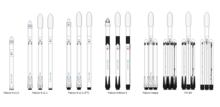
Back Seznam letů Falconu 9 a Falconu Heavy Czech Liste der Falcon-9- und Falcon-Heavy-Raketenstarts German Anexo:Lanzamientos de cohetes Falcon 9 y Falcon Heavy Spanish Luettelo Falcon-rakettiperheen laukaisuista Finnish Liste des vols de SpaceX French Lanci del Falcon 9 e del Falcon Heavy Italian ファルコン9の打ち上げ履歴 Japanese 팰컨 9 / 팰컨 헤비 발사 목록 Korean Lijst van lanceringen van Falcon 9 en Falcon Heavy Dutch Lista startów rakiet Falcon 9 oraz Falcon Heavy Polish

Since June 2010, rockets from the Falcon 9 family have been launched 337 times, with 335 full mission successes, two failures,[a] and one partial success. Designed and operated by SpaceX, the Falcon 9 family includes the retired versions Falcon 9 v1.0, v1.1, and v1.2 "Full Thrust" (blocks 3 and 4), along with the currently active Block 5 evolution. Falcon Heavy is a heavy-lift derivative of Falcon 9, combining a strengthened central core with two Falcon 9 first stages as side boosters.[1]
The Falcon design features reusable first-stage boosters, which land either on a ground pad near the launch site or on a drone ship at sea.[2] In December 2015, Falcon 9 became the first rocket to land propulsively after delivering a payload into orbit.[3] This reusability results in significantly reduced launch costs, as the cost of the first stage constitutes the majority of the cost of a new rocket.[4][5] Falcon family boosters have successfully landed 301 times in 312 attempts. A total of 42 boosters have flown multiple missions, with a record of 20 missions by a booster. SpaceX has also reflown fairing halves more than 300 times, with some being reflown for eleven or more times.[6]
Typical missions include launches of SpaceX's Starlink satellites (accounting for a majority of the Falcon manifest), Dragon crew and cargo missions to the International Space Station, and launches of commercial and military satellites to LEO, polar, and geosynchronous orbits. The heaviest payloads launched on Falcon are batches of 24 Starlink V2-Mini satellites weighing 17,500 kg (38,600 lb) total, a configuration first flown February 2024,[7] landing on ASDS. The heaviest payload launched to geostationary transfer orbit (GTO) was the 9,200 kg (20,300 lb) Jupiter-3 on 29 July 2023. Launches to higher-orbits have included DSCOVR to Sun–Earth Lagrange point L1, TESS to a lunar flyby, a Tesla Roadster to a heliocentric orbit extending past the orbit of Mars, DART to the asteroid Didymos, Euclid to Sun-Earth Lagrange point L2, and Psyche to the asteroid Psyche.
Cite error: There are <ref group=lower-alpha> tags or {{efn}} templates on this page, but the references will not show without a {{reflist|group=lower-alpha}} template or {{notelist}} template (see the help page).
- ^ "Falcon 9 Overview". SpaceX. 8 May 2010. Archived from the original on 5 August 2014.
- ^ Simberg, Rand (8 February 2012). "Elon Musk on SpaceX's Reusable Rocket Plans". Popular Mechanics. Archived from the original on 24 June 2017. Retrieved 2 November 2017.
- ^ Wall, Mike (21 December 2015). "Wow! SpaceX Lands Orbital Rocket Successfully in Historic First". Space.com. Archived from the original on 15 August 2017. Retrieved 17 August 2017.
- ^ Smith, Rich (5 October 2020). "How Much Cheaper Are SpaceX Reusable Rockets? Now We Know". The Motley Fool. Archived from the original on 15 May 2022. Retrieved 21 May 2022.
- ^ Brown, Mike (22 August 2020). "SpaceX: Elon Musk breaks down the cost of reusable rockets". Inverse. Archived from the original on 23 August 2020. Retrieved 21 May 2022.
- ^ "In 2023, SpaceX completed 96 successful missions, safely flew 12 more astronauts to orbit, launched two flight tests of Starship, and more than doubled the number of people around the world connected by @Starlink. Watch @elonmusk deliver a company update". X (formerly Twitter). Archived from the original on 13 January 2024. Retrieved 13 January 2024.
- ^ Sesnic, Trevor (25 February 2024). "Starlink Group 6-39 – Falcon 9 Block 5". Everyday Astronaut. Retrieved 25 February 2024.
© MMXXIII Rich X Search. We shall prevail. All rights reserved. Rich X Search